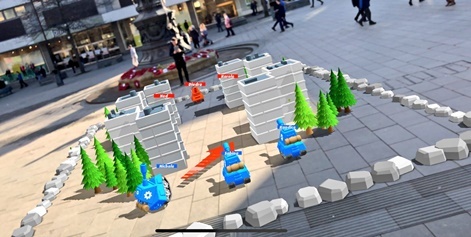Augmented reality-focused developers recently found themselves treated to the reveal of ARKit 2 at Apple's recent WWDC Keynote in early June. The announcement not only set itself apart by lining up a host of new features but by also serving as a milestone.
After all, it wasn't so long ago that the initial launch of ARKit brought AR capabilities to developers who it may have been out of reach for beforehand.
Among the new features coming with ARKit 2 include shared experiences, which lets multiple users interact with the same game or project a spectator mode that can also be added for friends and family.
Another addition is the new Persistent AR feature that lets users interact with virtual objects.
One indie studio to benefit from ARKit is Smash Tanks! developer Dumpling Design, which has taken to the fancies of AR design following the implementation of ARKit.
To garner a better sense of what has been and what is to come with ARKit 2 we caught up with Dumpling Design founder and Sega alumni Travis Ryan to talk about Smash Tanks! and his relationship with the tech.
PocketGamer.Biz: Did you do much work with AR before ARKit? How accessible was the tech?
Travis Ryan: Absolutely zero. We’d been prototyping a new kind of mobile board game to play with my kids, but it didn’t really go anywhere until Apple announced ARKit at WWDC17. The light bulb went off and I thought we could ‘Star Wars Holo Chess’ the prototype.
Over the course of a day, the game went from 2D top-down tank-flinging prototype to chasing life-sized tanks down the office corridors.
We had zero experience developing with AR before that day, it was beyond the scope of our three dev team. The rest we learnt and made-up as we went along.
Do you think ARKit has been a success? How has it been for indies?
It created the largest AR platform overnight and gave developers a powerful toolkit to play with, so it’s been hugely successful in that regard.
As we’re still writing the rulebook for great AR experiences, it’s a perfect time for indies to get involved and flex their creativity.

What features from ARKit proved particularly useful?
Apple does most of the heavy lifting; plain detection, anchoring, light estimation; all of the big technical challenges.
But really it's out-of-box accessibility and robustness as a technology that is its biggest win.
Certainly for us, working in Unity with the ARKit plugin has allowed us to concentrate on the real challenge of making something fun and popular.
So a lot of our job is hiding and encouraging the technology through play, so our kids jump right in and play and grandma can give it a try.Travis Ryan
What kind of design challenges does AR throw up when making mobile games?
As well as creating something that’s fun to play with, you’re always mindful of creating something that ‘just works’.
We spend a lot of time challenging things like scanning and set-up, and now multiplayer synchronisation because any amount of friction kills the magic and your potential audience along with it.
So a lot of our job is hiding and encouraging the technology through play, so our kids jump right in and play and grandma can give it a try.
It’s been a learning curve designing in the real world too as things need to behave in ways you’d expect them to behave right in front of your eyes. It’s harder to hide behind the abstract ‘gamey’ tropes we're accustomed to, it can feel more like product design in that sense.
Does multiplayer make things trickier?
Not really. We knew we were making a tactile, shared space multiplayer game and that provided a lot of focus when we started Smash Tanks! and helped us pick our battles.
For instance, we didn’t need to solve shared point data or persistence at the time as during prototypes most players seemed to naturally ‘face-off’ and establish a space between each other.
As each player has their own device and view of the game, the challenge is grabbing and directing their attention at the right time so everyone feels part of the fun.
ARKit 2.0 arrived just in the nick of time for AR Game number two, as up to eight players can race around a shared track that your environment can effect. Having that persistence across all players is key for us.
Have you found AR to be popular and a viable platform to release a game on?
It depends on the platform; we’ve had moderate success on iOS as a premium app (£1.99), but have been far less successful on Android to the point that it’s no longer viable for us as a platform.
ARKit 2.0 seals the deal, having effectively leapfrogged the competition to the point we’d need to develop entirely separate SKUs of a game.Travis Ryan
ARKit 2.0 seals the deal, having effectively leapfrogged the competition to the point we’d need to develop entirely separate SKUs of a game. So it makes sense for us to focus on iOS and ARKit, and Apple’s support and belief in its technology are super encouraging to us as developers.
Still, there’s a lot to figure out when it comes to making money in AR. The session-based nature of active AR play means traditional free-to-play shenanigans don’t apply - at least not for us - while traditional ads and interstitials are far too obstructive. All of this makes going free difficult and brings us to AR’s biggest challenge: audience.
Getting the wider audience to see AR beyond Pokemon Go and Snapchat lenses needs for more effective ways to introduce the fun and practicality of AR. A huge marketing push akin to Nintendo’s introduction of the Wii wouldn’t go amiss, but really it comes down to us as developers.
So while we’re still in the ‘being first to dance and convincing everyone to dance with us’ phase of AR, our goal in the coming months is to remove some of those barriers preventing people from trying and sharing our AR experiences.
What kind of opportunities do you see coming with ARKit 2.0?
I hope we start seeing new types of shared social experiences, whether that’s games or something more creative or practical, 2.0 is a good step toward robust persistent data needed for AR to evolve.
Was there anything you didn’t see that you would have liked to from the ARKit 2.0 reveal?
Dynamic object detection, collision and occlusion would have been the icing on the cake for our current experiments. But given the recent progress we may see this sooner than you think.
That’s the benefit of Apple's ecosystem, it can evolve its core technology at such a rapid pace. We released AR Smash Tanks! in December and already we’ve had two major platform revisions introducing vertical surfaces and now persistent multiplayer, and each update improves the baseline refresh and performance.
At the rate things are going we’ll be wearing AR glasses by 2020, a date I’m sure isn’t lost on those clever marketing types.





















